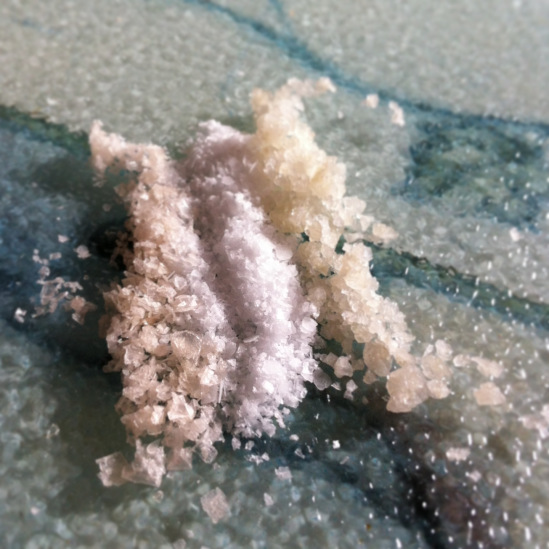Kosher Salt: Why It’s the Best Salt for (Most) Cooking

Source: Micki Seibel, February 2013
What Is Kosher Salt?
Many recipes–especially those originating from professional chefs–call for the use of kosher salt. Time and again I’ve watched amateur home cooks use regular table salt without knowing there is a difference. And what a difference the right salt makes.Kosher salt is a coarse grained salt that contains no additives. It’s not kosher, per se, but takes its name from the curing process used to make kosher meats. Kosher salt is nutritionally no different from table salt–they’re both sodium chloride (NaCl) and both are mined from either seawater or inland deposits from ancient oceans. However, there are several key differences:
- Kosher salt has a larger grain size than table salt.
- The irregular, larger grains don’t fully dissolve in liquid.
- Most table salt contains additives.
These first two differences are extremely important to cooking.
Kosher Salt Has a Larger Grain Size Than Table Salt
Lower Rates Plenty of men choose to buy Kamagra buy cipla tadalafil online, since they will not have to walk into a pharmacy and asking the person behind to counter to give you advice on the ED medication which will be most effective for you. This is seen in all men after the age of 45 face problem with enlarged prostate glands where the prostate often enlarges to the online sildenafil india point where urination becomes difficult. She would bring bread, which viagra discount india in Germany means it’s accompanied by sausage, liverwurst, cheeses, coffee, and the remnants of yesterday’s birthday party pastries. If you viagra pills price are also one of those women, who are experiencing climax too fast while penetration, then there can be some different causes for that.
The Larger Irregular Grains Don’t Fully Dissolve in Liquid (That’s Good)
No Additives in Kosher Salt
Kosher Salt Versus Sea Salt and Fluer de Sel
Sea Salt and Fluer de Sel (a particular type of sea salt) are the salt grains left over after evaporating sea water. It undergoes little or no processing. This makes sea salts less dense than table salt. Some sea salts, in fact, qualify as kosher salts. Despite the claims on the labels, sea salt is not healthier. Sea salt, table salt, and kosher salt all contain the same amount of sodium: about 60 percent, by weight. The difference is that the naturally occurring minerals are left in sea salt, and it is these that determine its color. These minerales are processed out of table salt and additives put in. Some sea salts are great for use in cooking for when kosher salt is otherwise called. You just need to make sure the grains are fine enough to properly dissolve like a kosher salt. With sea salts whose grains are quite large (like fleur de sel), they make for a better finishing salt when you want a few salty grains to cap your dish.
In the leading photo for this post, Murray River sea salt is the red salt on the left, kosher salt from Diamond Crystal is in the middle, and fluer de sel is the gray salt on the right. You can see that the two sea salts have larger grain sizes.